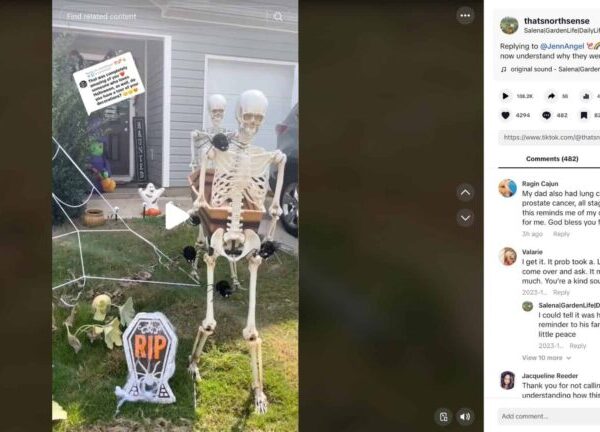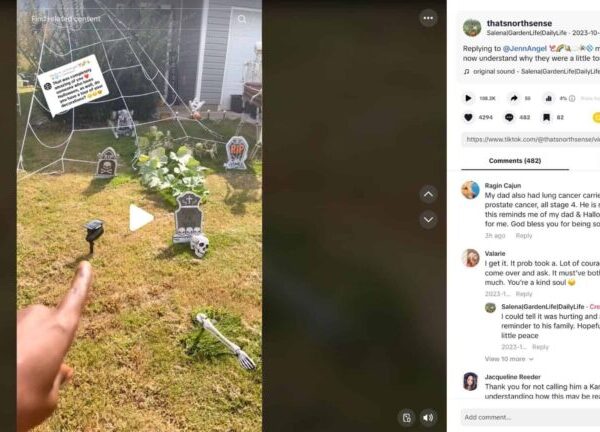
Salena Webb, a mother and devoted Halloween enthusiast from Duncan, South Carolina, recently gained nationwide attention after her thoughtful response to a neighbor’s unusual request went viral on TikTok.
Known locally for her creativity and her love of spooky holiday decorations, Webb had transformed her front yard into an elaborate graveyard, complete with life-like tombstones, skeletons holding coffins, cobwebs, eerie lighting, and other frightful details that made her home the highlight of the neighborhood every October.
Her goal had always been simple: to bring Halloween cheer, excitement, and a touch of frightful fun to the community.
Families walking or driving by her home could not help but pause, point, and smile at the creativity and effort behind the decorations.
Webb’s dedication reflected her lifelong love of Halloween, a holiday she considered a time for imagination, creativity, and shared enjoyment.
However, the very display intended to spread joy unexpectedly became a source of concern for one neighboring family.
An Unexpected Plea
The situation began when Webb’s neighbor—an adult man whose father had recently received a cancer diagnosis—expressed concern about the display.
While the graveyard decorations were impressive and clearly designed for fun, they unintentionally evoked feelings of distress for his father.
The visual reminder of tombstones and skeletons stirred thoughts of mortality that were particularly sensitive given his father’s health challenges.
The neighbor’s message was polite but firm: could Webb consider removing or modifying the graveyard setup to spare his father discomfort during an already difficult time? Initially, Webb was taken aback.
The decorations represented weeks of careful planning and assembly, and the thought of dismantling them felt disappointing. Yet she quickly recognized the importance of empathy over personal preference.
Instead of reacting defensively or dismissively, Webb decided to comply with the request. She did more than just remove the coffin-holding skeletons—she completely disassembled the graveyard portion of her display.
Her decision reflected her belief that human connection and kindness outweigh temporary personal enjoyment.

Kindness Over Confrontation
Webb explained her reasoning in a TikTok video that quickly gained traction, amassing over 1.2 million views.
She emphasized that acts of kindness do not come with a cost and that helping someone navigate a difficult moment was more important than keeping her Halloween decorations intact.
“There’s always next year for me,” she said, highlighting her ability to view the situation with both compassion and perspective.
Viewers were deeply moved. Many praised Webb for her maturity and empathy, noting that her decision demonstrated the kind of thoughtful behavior often lacking in online and neighborhood interactions.
Comments ranged from simple expressions of admiration—“You’re an amazing person!”—to reflections on how small acts of consideration can have profound impacts on those around us.
Creativity Meets Empathy
Even after removing the more “morbid” elements of her display, Webb’s Halloween spirit remained undimmed.
Rather than abandoning her decorations entirely, she adapted them in creative and humorous ways.
The skeletons that had once held coffins were repositioned to hold badminton rackets, while other props were repurposed to create a whimsical, lighter display.
The result was a festive and engaging presentation that maintained the celebratory nature of Halloween while respecting her neighbor’s sensitivities.
This inventive approach underscored the idea that empathy and creativity are not mutually exclusive.
By finding a solution that satisfied both her own desire to celebrate the holiday and her neighbor’s need for comfort, Webb demonstrated a model for resolving conflicts in a positive, constructive manner.
Strengthening Community Bonds
Webb’s considerate actions did not go unnoticed by her neighbors. She visited the family in person, bringing balloons and a heartfelt note to convey her support.
The family expressed their gratitude, telling her, “You’re good people,” and noting that her actions had brought peace and comfort during a stressful period.
This simple act of neighborly kindness strengthened the community bond, turning what could have been a source of tension into a moment of genuine human connection.
Social media users were quick to highlight the rarity of such thoughtful responses. In an environment often dominated by conflict, sarcasm, or online disputes, Webb’s story stood out as a beacon of empathy.
Her actions reminded viewers that even small gestures—like modifying a Halloween display—can have meaningful and lasting effects.

A Lesson in Empathy
Webb’s story serves as a broader lesson on the power of empathy and kindness. While her decision involved something as seemingly simple as seasonal decorations, the impact was profound.
She transformed a potentially uncomfortable situation into a heartwarming example of consideration, demonstrating that understanding and compassion can prevent conflict and foster goodwill.
Even as Halloween returns each year, the significance of Webb’s actions extends far beyond the holiday.
Her story reminds us that being mindful of others’ feelings, especially during difficult times, can transform ordinary moments into acts of generosity. I
n her case, the holiday became an opportunity not just for celebration but for human connection.
The Broader Cultural Context
The story of Salena Webb also highlights the growing influence of social media in shaping narratives of community behavior.
Platforms like TikTok allow acts of empathy and kindness to reach a wide audience, inspiring others to reflect on their own actions and encouraging a culture of consideration.
Webb’s video exemplifies how thoughtful behavior, when shared online, can spread positivity and prompt meaningful dialogue about compassion in everyday life.
Halloween, a holiday celebrated by millions across the United States, has often been associated with playful fear and elaborate displays.
Yet Webb’s story reminds us that decorations and holiday traditions do not exist in isolation.
They interact with the lives and experiences of those around us, and thoughtful adjustments can turn potentially negative interactions into moments of mutual respect and understanding.
Small Gestures, Big Impact
The response to Webb’s actions underscores the importance of small gestures.
A simple act—removing or modifying Halloween props—created a ripple effect of goodwill, strengthened community ties, and left a lasting impression on both the neighbor’s family and viewers across the country.
It is a powerful example of how mindfulness, empathy, and creativity can coexist, even in situations that might initially seem trivial or mundane.
Her story demonstrates that compassion is not just about grand gestures; it is often the thoughtful, considerate choices made in everyday life that leave the deepest impact.
By prioritizing the comfort of others, Webb not only diffused a potentially tense situation but also provided a model for how to navigate interpersonal challenges with grace and integrity.
Conclusion
Salena Webb’s Halloween display may have been dismantled, but the legacy of her actions continues to resonate.
Her ability to balance creativity, personal enjoyment, and empathy serves as an inspiring reminder that kindness is both powerful and contagious.
In a world where conflicts—both online and offline—are increasingly common, Webb’s response demonstrates that thoughtfulness and understanding can transform ordinary moments into lasting positive memories.
As communities everywhere prepare for the next Halloween season, Webb’s story stands as a testament to the fact that holiday traditions can be adapted with care and consideration.
Small gestures, like reimagining a display for a neighbor’s comfort, may seem minor, but their effects are profound, reinforcing the idea that empathy, generosity, and community spirit are invaluable at any time of year.
In short, Webb’s thoughtful decision transformed a potential disagreement into a lesson in compassion, illustrating how even simple acts of kindness can leave an enduring impact and serve as inspiration for others to follow.
Salena Webb, a mother and devoted Halloween enthusiast from Duncan, South Carolina, recently gained nationwide attention after her thoughtful response to a neighbor’s unusual request went viral on TikTok.
Known locally for her creativity and her love of spooky holiday decorations, Webb had transformed her front yard into an elaborate graveyard, complete with life-like tombstones, skeletons holding coffins, cobwebs, eerie lighting, and other frightful details that made her home the highlight of the neighborhood every October.
Her goal had always been simple: to bring Halloween cheer, excitement, and a touch of frightful fun to the community.
Families walking or driving by her home could not help but pause, point, and smile at the creativity and effort behind the decorations.
Webb’s dedication reflected her lifelong love of Halloween, a holiday she considered a time for imagination, creativity, and shared enjoyment.
However, the very display intended to spread joy unexpectedly became a source of concern for one neighboring family.
An Unexpected Plea
The situation began when Webb’s neighbor—an adult man whose father had recently received a cancer diagnosis—expressed concern about the display.
While the graveyard decorations were impressive and clearly designed for fun, they unintentionally evoked feelings of distress for his father.
The visual reminder of tombstones and skeletons stirred thoughts of mortality that were particularly sensitive given his father’s health challenges.
The neighbor’s message was polite but firm: could Webb consider removing or modifying the graveyard setup to spare his father discomfort during an already difficult time? Initially, Webb was taken aback.
The decorations represented weeks of careful planning and assembly, and the thought of dismantling them felt disappointing. Yet she quickly recognized the importance of empathy over personal preference.
Instead of reacting defensively or dismissively, Webb decided to comply with the request. She did more than just remove the coffin-holding skeletons—she completely disassembled the graveyard portion of her display.
Her decision reflected her belief that human connection and kindness outweigh temporary personal enjoyment.

Kindness Over Confrontation
Webb explained her reasoning in a TikTok video that quickly gained traction, amassing over 1.2 million views.
She emphasized that acts of kindness do not come with a cost and that helping someone navigate a difficult moment was more important than keeping her Halloween decorations intact.
“There’s always next year for me,” she said, highlighting her ability to view the situation with both compassion and perspective.
Viewers were deeply moved. Many praised Webb for her maturity and empathy, noting that her decision demonstrated the kind of thoughtful behavior often lacking in online and neighborhood interactions.
Comments ranged from simple expressions of admiration—“You’re an amazing person!”—to reflections on how small acts of consideration can have profound impacts on those around us.
Creativity Meets Empathy
Even after removing the more “morbid” elements of her display, Webb’s Halloween spirit remained undimmed.
Rather than abandoning her decorations entirely, she adapted them in creative and humorous ways.
The skeletons that had once held coffins were repositioned to hold badminton rackets, while other props were repurposed to create a whimsical, lighter display.
The result was a festive and engaging presentation that maintained the celebratory nature of Halloween while respecting her neighbor’s sensitivities.
This inventive approach underscored the idea that empathy and creativity are not mutually exclusive.
By finding a solution that satisfied both her own desire to celebrate the holiday and her neighbor’s need for comfort, Webb demonstrated a model for resolving conflicts in a positive, constructive manner.
Strengthening Community Bonds
Webb’s considerate actions did not go unnoticed by her neighbors. She visited the family in person, bringing balloons and a heartfelt note to convey her support.
The family expressed their gratitude, telling her, “You’re good people,” and noting that her actions had brought peace and comfort during a stressful period.
This simple act of neighborly kindness strengthened the community bond, turning what could have been a source of tension into a moment of genuine human connection.
Social media users were quick to highlight the rarity of such thoughtful responses. In an environment often dominated by conflict, sarcasm, or online disputes, Webb’s story stood out as a beacon of empathy.
Her actions reminded viewers that even small gestures—like modifying a Halloween display—can have meaningful and lasting effects.

A Lesson in Empathy
Webb’s story serves as a broader lesson on the power of empathy and kindness. While her decision involved something as seemingly simple as seasonal decorations, the impact was profound.
She transformed a potentially uncomfortable situation into a heartwarming example of consideration, demonstrating that understanding and compassion can prevent conflict and foster goodwill.
Even as Halloween returns each year, the significance of Webb’s actions extends far beyond the holiday.
Her story reminds us that being mindful of others’ feelings, especially during difficult times, can transform ordinary moments into acts of generosity. I
n her case, the holiday became an opportunity not just for celebration but for human connection.
The Broader Cultural Context
The story of Salena Webb also highlights the growing influence of social media in shaping narratives of community behavior.
Platforms like TikTok allow acts of empathy and kindness to reach a wide audience, inspiring others to reflect on their own actions and encouraging a culture of consideration.
Webb’s video exemplifies how thoughtful behavior, when shared online, can spread positivity and prompt meaningful dialogue about compassion in everyday life.
Halloween, a holiday celebrated by millions across the United States, has often been associated with playful fear and elaborate displays.
Yet Webb’s story reminds us that decorations and holiday traditions do not exist in isolation.
They interact with the lives and experiences of those around us, and thoughtful adjustments can turn potentially negative interactions into moments of mutual respect and understanding.
Small Gestures, Big Impact
The response to Webb’s actions underscores the importance of small gestures.
A simple act—removing or modifying Halloween props—created a ripple effect of goodwill, strengthened community ties, and left a lasting impression on both the neighbor’s family and viewers across the country.
It is a powerful example of how mindfulness, empathy, and creativity can coexist, even in situations that might initially seem trivial or mundane.
Her story demonstrates that compassion is not just about grand gestures; it is often the thoughtful, considerate choices made in everyday life that leave the deepest impact.
By prioritizing the comfort of others, Webb not only diffused a potentially tense situation but also provided a model for how to navigate interpersonal challenges with grace and integrity.
Conclusion
Salena Webb’s Halloween display may have been dismantled, but the legacy of her actions continues to resonate.
Her ability to balance creativity, personal enjoyment, and empathy serves as an inspiring reminder that kindness is both powerful and contagious.
In a world where conflicts—both online and offline—are increasingly common, Webb’s response demonstrates that thoughtfulness and understanding can transform ordinary moments into lasting positive memories.
As communities everywhere prepare for the next Halloween season, Webb’s story stands as a testament to the fact that holiday traditions can be adapted with care and consideration.
Small gestures, like reimagining a display for a neighbor’s comfort, may seem minor, but their effects are profound, reinforcing the idea that empathy, generosity, and community spirit are invaluable at any time of year.
In short, Webb’s thoughtful decision transformed a potential disagreement into a lesson in compassion, illustrating how even simple acts of kindness can leave an enduring impact and serve as inspiration for others to follow.